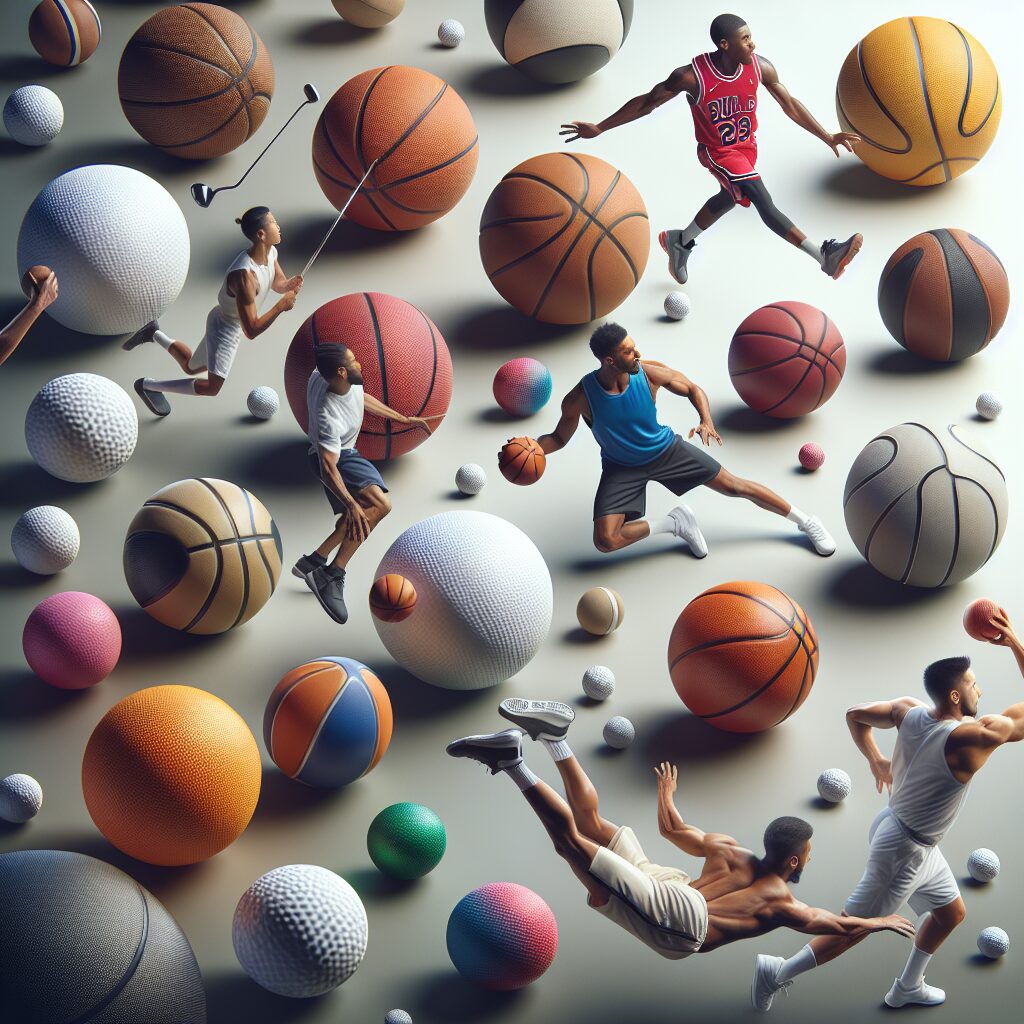Player Development: The Impact of Ball Size
In the world of sports, player development is a crucial aspect that determines an athlete’s growth and success. Whether it’s basketball, soccer, or tennis, the size of the ball used in training and matches can have a significant impact on a player’s skill development. Did you know that the size of the ball can change the way players perceive the game and interact with their surroundings? This unique insight brings us to the question – how does ball size affect player development? Let’s explore the various specific impacts and unique features that arise from using different ball sizes, and delve into the key takeaways that players and coaches need to be aware of to enhance their training and performance.
Different ball sizes in sports have been proven to have specific impacts on player development. Take basketball, for example. Young players often start with smaller-sized basketballs to enhance their hand-eye coordination and dribbling skills. As they grow older and move to a higher level of competition, they transition to standard-sized basketballs to develop their shooting and passing abilities. By adapting to different ball sizes at various stages of their development, players not only improve their technical skills but also enhance their overall game understanding.
Similarly, the impact of ball size is evident in soccer as well. For junior players, smaller-sized soccer balls enable better control, footwork, and precision in passing. As they progress through different age groups, transitioning to larger-sized balls is essential as it requires more power and accuracy during shooting and long passes. This progression in ball size ensures that players develop the necessary skills and adapt to different playing conditions, ultimately preparing them for higher-level competition.
Now that we have explored the impacts of ball size on player development in basketball and soccer, let’s discuss the key takeaways from this article. Understanding the importance of ball size in player development can help coaches design effective training programs and drills that cater to specific skill requirements at each stage of a player’s journey. It also emphasizes the significance of gradual progression from smaller to larger-sized balls to ensure well-rounded skill development. By being mindful of these key takeaways, players and coaches can optimize their training methods and elevate their performance on the field.
Key Takeaways
1. The size of the ball used in player development can have a significant impact on skill acquisition, technique, and overall performance.
2. Using smaller-sized balls for younger players can promote better skill development, as it encourages more touches on the ball and improved ball control.
3. Conversely, using larger-sized balls for older players can enhance physical development, strength, and power by challenging their ability to strike and control a heavier ball.
4. Coaches and trainers should consider incorporating a progressive approach to ball size, starting with smaller balls and gradually increasing the size as players progress in age and ability.
5. The choice of ball size should be based on the specific developmental needs of the players, taking into account their age, skill level, and desired areas of improvement.
How does ball size impact player development?
Importance of Ball Size in Sports
In the world of sports, ball size plays a crucial role in player development. Various factors such as age, skill level, and sport type determine the appropriate ball size for optimal performance. Understanding the impact of ball size on player development is essential for coaches, athletes, and parents alike.
Motor Skills Development
The choice of ball size directly influences the development of motor skills among players. For young athletes, using an oversized ball during practice can enhance hand-eye coordination, grip control, and overall dexterity. As they progress, gradually transitioning to a regulation-sized ball improves accuracy, power, and technique.
Preventing Injuries
Using the correct ball size is crucial to prevent injuries, particularly in children. When the ball is too heavy or too large, it can strain the muscles and joints, leading to overuse injuries or improper technique. By matching the ball size to the player’s physical abilities, the risk of injury decreases, and their development is more sustainable.
Training Efficiency
Optimizing player development involves efficient training methods, and the choice of ball size is a significant factor. Using smaller balls for specific drills can challenge players’ skills, speed, and agility. This allows athletes to improve their reaction time, decision-making, and overall game performance, as they adapt to the demands of the smaller ball.
Transitioning to Regulation-sized Balls
When players reach the appropriate skill level and age, transitioning to regulation-sized balls becomes necessary. This process prepares them for real-game scenarios and ensures that their skills translate well onto the field. Adequate practice with regulation-sized balls is crucial to enhance accuracy, control, and the ability to perform at their best during competitive play.
Choosing the Right Ball Size
Determining the correct ball size for player development requires consideration of several factors. These include the player’s age, physical abilities, skill level, and the requirements of the sport. Consulting with coaches, trainers, and utilizing size charts provided by sporting associations can assist in making informed decisions.
Conclusion
By understanding the impact of ball size on player development, coaches, parents, and athletes can optimize training methods and reduce the risk of injuries. Proper ball size selection promotes the development of motor skills, enhances training efficiency, and prepares players for competitive play. Remember, choosing the right ball size is vital in nurturing athletes and helping them reach their full potential.
Guides to Maximize Player Development with Ball Size:
1. How should coaches determine the appropriate ball size for young athletes?
2. What are the indications that a player is ready to transition to a regulation-sized ball?
3. Are there any recommended drills or exercises using different ball sizes to enhance players’ skills?
4. How can parents encourage the use of appropriate ball size to prevent injuries during casual play?
5. Are there any resources available to help coaches and parents understand the recommended ball size for specific sports?
Frequently Asked Questions
1. What is player development?
Player development refers to the process of nurturing and enhancing the skills, abilities, and potential of an athlete. It involves various training techniques, practice drills, and strategies to improve performance and achieve optimal results.
2. How does ball size impact player development?
The size of the ball used in training and competitive play significantly affects player development. A smaller ball encourages better ball control, improved accuracy, and enhanced coordination. It also facilitates quicker decision-making and develops faster reaction times.
3. At what age should ball size be modified during player development?
The appropriate time to modify ball size in player development varies depending on the sport. Generally, it is recommended to gradually introduce smaller balls around the age of 6-8 years old to help young athletes develop proper technique and skill acquisition.
4. Are there any disadvantages to using a smaller ball during player development?
While using a smaller ball can have numerous benefits, it may pose challenges for beginners or players transitioning from larger to smaller balls. It requires adjustment in terms of grip, control, and power. However, these difficulties are temporary and can be overcome with consistent practice and gradual adaptation.
5. Which sports commonly modify ball size for player development?
Several sports modify ball size for player development, including soccer, basketball, tennis, and volleyball. The adjustment in ball size is aimed at improving skill development, promoting better technique, and enhancing overall performance.
6. Does using a smaller ball exclusively in training translate to better performance in real game situations?
While training with a smaller ball can have significant positive impacts on player development, it is essential to ensure a balance between using smaller and regulation-sized balls. This helps players develop skills needed for both controlled practice environments and actual game scenarios.
7. Can transitioning from a smaller to a larger ball hinder player development?
No, transitioning from a smaller to a larger ball typically does not hinder player development. The skills acquired from training with a smaller ball, such as improved ball control and coordination, can generally be transferred and adapted to larger ball sizes.
8. How often should ball size be modified in player development?
The frequency of modifying ball size in player development depends on the individual athlete’s progress and skill level. Coaches and trainers may gradually introduce larger balls as the player’s proficiency improves to continuously challenge them and allow for further skill refinement.
9. Is there scientific evidence supporting the impact of ball size on player development?
Yes, numerous studies and research have highlighted the positive impact of ball size on player development. These studies provide empirical evidence supporting the effectiveness of using smaller balls in skill acquisition, agility improvement, and overall performance enhancement.
10. How can coaches and trainers effectively incorporate ball size modifications in player development?
Coaches and trainers can effectively incorporate ball size modifications by designing specific training drills and exercises that target different aspects of player development. Gradually introducing smaller balls, incorporating skill-specific challenges, and providing sufficient practice opportunities contribute to optimal player growth and performance.
Final Thoughts
Player development is a multifaceted process that requires careful consideration of various factors, including the impact of ball size. By recognizing the benefits of using smaller balls in training and gradually modifying ball size, athletes can experience enhanced ball control, improved coordination, and heightened performance.
However, it is important to strike a balance between training with different ball sizes to ensure players are prepared for various game situations. Coaches and trainers play a vital role in designing effective drills and exercises that maximize player development while considering individual skill levels and progression. Ultimately, prioritizing player development through appropriate ball size modifications can lead to a more well-rounded and skilled athlete.




